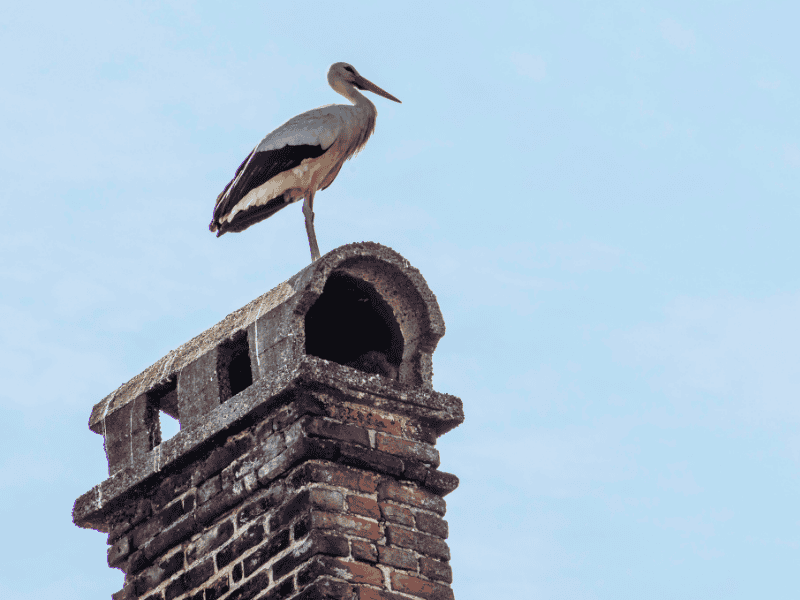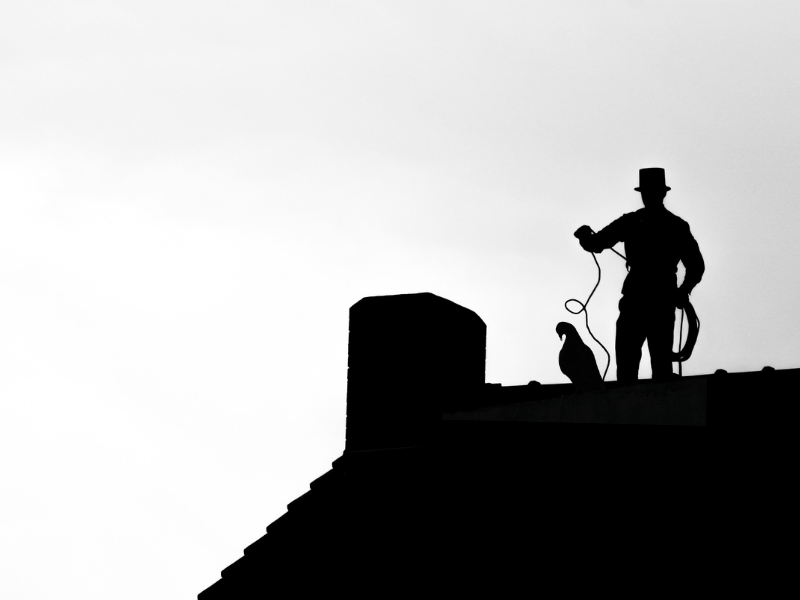A bird that has been trapped in your chimney could be a stressful situation for the bird and you, so it’s important to deal with the situation with attention. If you follow the correct steps, you’ll be able to remove the bird without risking injury or injury, and also keep it from happening again.
Why Do Birds End Up in Chimneys?

Birds often flock to chimneys for a myriad of reasons, mostly looking for warmth and shelter. The cosy, peaceful and safe environment chimneys offer can seem to be the ideal spot bird roost, rest or build nests. Here are a few most important reasons birds find themselves in chimneys:
- Want to Warmth The birds naturally seek warmth particularly in colder weather. When winter is here the warm air that rises from your fireplace could draw birds looking for a warm, secure area to rest.
- Natural Nesting Sites Chimneys are modeled after the environment found in a typical tree crevice or cavity providing a private and protected area for birds to construct nests, with a focus on smaller species like sparrows swallows, and starlings.
- The lack of safe Alternatives In urban areas birds are often unable to find safe places to nest due to the lack of natural space which is why chimneys can be an attractive option.
- Birds that aren’t experienced Inexperienced or young birds can accidentally fly into chimneys, without noticing how difficult it will be in getting out.
Identifying the Problem
Before attempting to get rid of the bird, it is essential to confirm that the bird is actually trapped within the chimney. The indicators of a bird that is trapped may differ, but keep an eye out for the following indicators:
- Auditory clues If you can are constantly hearing chirping, singing or a frenzied swooping sound coming out of the chimney it’s a sure signal that a bird is trapped within. Birds usually make noises when they feel uneasy or trapped.
- Visual evidence In certain instances you might be able observe the bird perched at in the upper part of the chimney gazing out, or observe droppings or feathers near the chimney’s opening. Be sure to keep a safe distance from the bird and try not to startle the bird.
- Smoke or venting issues If your bird is trapped for a while and you notice that your chimney isn’t correctly venting smoke, or you are experiencing backdrafts in your chimney. It is also possible to smell something strange or notice that the fireplace is not working as it should.
Steps to Get a Bird Out of Your Chimney
1. Ensure Your Fireplace is Safe to Use
Before attempting to take the bird out make sure that the stove or fireplace isn’t being used and that no heat or smoke is entering the house. Birds may become confused or even damaged by smoke or heat of a flame.
- Switch off appliances powered by gas If you have a fireplace that is gas-powered, turn off the gas as soon as you can to stop the bird from being injured by flames or smoke.
- Stop the fireplace If your fireplace is equipped with doors or screens shut them off to stop birds from fleeing into your home, creating more chaos. Also, it will not escape into other rooms and become more stressed.
- Verify for obstruction Check your chimney’s venting systems to make sure that there are no obstructions. If you find an obstruction and you can see an animal trapped within it’s crucial to act swiftly before the bird is exposed to dangers.
2. Check for an Access Point at the Top of the Chimney
In this instance you are able to examine the top of your chimney to see whether there’s a solution to assist the bird. Based on the chimney’s design and the exact location where the bird was, you might be able of removing it.
- Make use of a flashlight When the bird appears to be stranded at the top of the chimney of the chimney, make use of the flashlight to examine within the interior of the chimney. This will enable you to locate the bird and know its position more clearly.
- Examine the chimney cap Certain chimneys come with caps that protect against animals, debris and large birds from getting. When a bird gets stuck close to the top of the chimney and isn’t blocked by the chimney cap you could use a pole or stick to gently direct the bird towards the opening.
3. Create a Safe Exit Path for the Bird
In the event that the bird seems be healthy and not injured it is possible to assist it in getting out by itself. In this scenario the most important thing is to eliminate any obstructions, and create an environment in which the bird is safe to fly away.
- The damper can be opened The damper an aluminum flap within the chimney, which controls the flow of air. The flap is fully opened to allow the bird to have a clear path through the chimney. This is usually the most effective method to provide the exit path.
- Window or doors In the event that a bird has been found situated close to the opening or close enough to the fireplace, it is possible to open windows or doors that are in close proximity to offer a way out. Birds are usually drawn by sunlight, and having access to a wide window could aid them in their quest for freedom.
- Dim the lights in your home To stop birds from being distracted by lighting in the interior dim or shut off the lights in your home. This can make the outdoor lights appear more attractive and encourage the bird to fly towards it.
- Keep calm and patient If the bird is frightened by abrupt movements or loud sounds the bird may become confused and confused. Maintain a calm environment and do not stress the bird even more. It may be necessary to give the bird a few days to figure out how to get it out.
From Chimneys birds can also enter fire place, explore How to Get a Bird Out of Your Fireplace in 7 Simple Steps.
4. Use a Rescue Pole or Rod (If Safe to Do So)
If the bird has become stuck higher in the chimney, or if it’s not accessible then you’ll need to remove it with an elastic rod or rescue pole.
- Use a flexible, long rod – a long broomstick or telescoping pole, as well as a special bird rescue rods will aid in moving your bird towards the chimney’s opening. Use a gentle touch and avoid any forceful movement, as it can cause stress or injury to the bird.
- Avoid getting anxious Moving slowly and cautiously, using an easy voice or gentle urging to stop the bird from becoming nervous. Birds are very sensitive to sudden movements and are easily scared thus the process needs patience.
- Be aware of your bird’s condition If the bird is particularly weak or injured, avoid from moving it in a violent manner. If you notice any of these signs, call an expert for assistance.
5. Call a Professional for Help

If a bird is trapped in an unaccessible location or removal causes distress to the bird it’s recommended to speak with an expert. There are numerous specialists who have been who are trained to safely and gently remove birds trapped in cages.
- Wildlife rescue experts A number of wildlife rescue groups are equipped to deal with situations such as this. These professionals are able to effectively remove the animal, without hurting it and can even help in rehabilitating it if required.
- Chimney sweeps Professional chimney sweeps are equipped with the equipment and know-how to deal with situations in which birds have become trapped deep in the chimney. They can free the bird using special equipment and make sure that the chimney remains safe and secure.
- Service for controlling pests When the animal is part the larger problem or infestation Pest control companies might be able to provide solutions to prevent any future problems with birds in your house.
6. Prevent Future Bird Entrances
Once you’ve eliminated the animal, it’s important to take preventive steps to stop future bird entry through your chimney.
- Install chimney caps The chimney cap that has a mesh screen will stop birds from getting into your chimney. Check that the holes aren’t too small to impede smaller birds, yet enough to permit adequate airflow.
- Chimney inspections on a regular basis Annual inspections: Schedule them by an experienced chimney sweeper to make sure there aren’t any structural weaknesses cracks, gaps, or holes that birds could get into.
- Signify entry points Examine your chimney’s exterior to find holes or cracks that could let birds in. Cover these gaps using the right substances to make your chimney bird-proof.
7. Monitor for Injuries and Seek Rehabilitation Help if Needed
Once the bird has been safely removed, be sure to monitor its condition. Birds can be injured due to the pressure of being in a cage or trying to escape.
- Find indications of injuries injuries such as bleeding, broken wings or exhaustion can require immediate intervention. If the bird seems injured, bring the bird to an animal rehabilitation specialist or a veterinarian for treatment.
- Contact a rehabilitation center If the bird requires medical care, a wildlife rehabilitation expert can offer care, assist bring the bird back to health, then let it go back into the wild once it’s healthy enough to fly again.
Conclusion
The removal of birds from your chimney does not have to be a difficult or dangerous procedure, but it takes patience, a calm attitude and a lot of the right amount of. If you take the proper method, you can aid the bird to escape and avoid future problems by taking the proper preventive steps. Always think about the safety and wellbeing of the bird and seek help from a professional when required.
If you follow these guidelines, you’ll not just address the immediate issue, but will also help in the protection of your wildlife and your own home.
